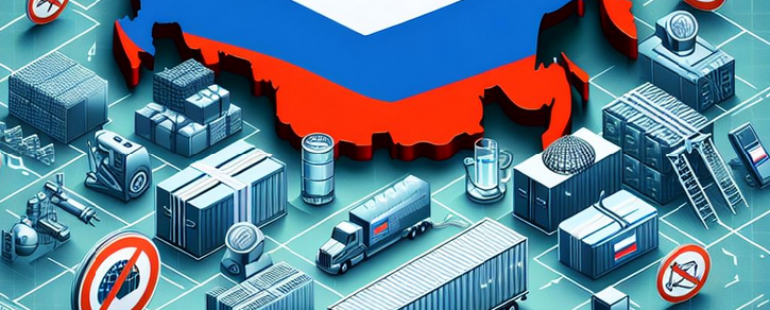
The Russian Federation has immediately implemented restrictions on the entry of certain commodities for transit through its territory by Government Decree No. 1374, dated October 15, 2024, which supplements the previous Decree No. 313, Amendment No. 3.
These prohibitions apply to goods that may have military or strategic significance, such as products related to mining, telecommunications, or industrial technologies.
According to information from railway operators, the Russian Federation will conduct random inspections. If a container contains goods with an excluded HS code, it will be removed from the train and may be subject to confiscation.
Below, we provide additional information, including recommended procedures.
1. Which items are affected by the regulation?
You can use the online tool at https://www.alta.ru/tnved/forbidden_export to verify specific HS codes.
The website is only available in Russian – for a general overview, you can use the automatic translation feature for easier navigation.
2. How to compare HS Codes
If an HS code in the document has more than 6 digits, compare it by the first 6 digits. If the first 6 digits match, the goods are subject to the restriction (transit ban).
If an HS code has fewer than 6 digits, compare it by the first 4 digits. If the first 4 digits match, the goods are subject to the restriction (transit ban).
3. What should be considered when comparing HS Codes
There may be slight differences between the codes in Russian documents (HS codes) and those used in Europe. However, the first 6 digits of the customs nomenclature (HS code) should generally be the same.
4. What Needs to Be Done Now?
- Determine the HS code for your goods.
When requesting railway transport, specify the type of commodity, including the HS code (customs nomenclature).
5. What Are the Risks of Transporting Prohibited HS Codes?
- Customs inspection and associated additional costs.
- Confiscation of the transported goods by the customs authorities of the Russian Federation.
- Additional costs incurred during the confiscation of goods – handling, storage, demurrage, transfers.
6. Is There an Option for Additional Insurance Against the Risk of Confiscation?
Unfortunately, no. This is due to:
- Sanction Clause: Regardless of all other provisions of this contract, the insurer will not provide insurance coverage or any other benefits if such action would be contrary to economic, trade, or financial sanctions and/or embargoes imposed by the UN Security Council, the European Union, or any national laws or regulations applicable to the parties to this insurance. This also applies to economic, trade, or financial sanctions and/or embargoes imposed by the United States or other countries, unless contrary to EU or national laws.
- Article 6 of the General Terms and Conditions: The insurer does not provide coverage for damages caused by: a) Confiscation, seizure, sanctions, or other interventions by state authorities.
7. What Are the Alternative Transport Routes Outside the Territory of the Russian Federation?
- Sea Transport T/T (transit time): 55-60 days* (port-to-port)
- Rail Corridor via the Caspian Sea (Middle Corridor) T/T (transit time): 35-45 days* (port-to-port)
- Rail-Air Corridor via Kazakhstan T/T (transit time): 14-20 days* (terminal-to-airport FRA)
- Air Transport T/T (transit time): 5-7 days* (airport-to-airport) depending on the origin and volume/weight of the shipment.
*The indicated transit times are approximate, subject to potential congestion and delays at terminals, ports, or airports along the entire transport route.
8. Recommended Procedure – Summary:
- Determine the HS code for your imported items.
- Check whether the HS code (either 4-digit or 6-digit) corresponds to the sanctions.
- If your goods (HS code) are subject to sanctions, consider an alternative transport route and inform your sender.
We will be as helpful as possible in the process and verification.
9. Definitions:
HS Code:
This is the code of the Harmonized System (HS) or customs nomenclature, which allows you to precisely identify your product and check which customs items and rules apply.
The classification of goods is a logical structure uniformly used by customs authorities worldwide. Countries use the HS system as the basis for customs tariffs and the collection of statistical data. They further divide the six-digit HS product categories into eight or more customs items for greater specificity.
The European Union uses eight-digit codes. HS codes are six-digit numbers that identify a specific type of goods. The first two digits indicate the chapter, the next two the heading, and the last two the subheading. This system allows customs officials and legislators to identify the same product using a numerical code, facilitating international trade and ensuring that all countries use the same rules for product classification.
Using the correct HS code is important for determining the customs duties and taxes applicable to the product. Incorrect classification can lead to incorrect calculation of duties and taxes, resulting in fines or detention of goods.
10. Sources:
- ConsultantPlus (RU) – https://www.consultant.ru/legalnews/26702/
- Alta.ru – Forbidden HS Codes (RU): https://www.alta.ru/tnved/forbidden_export
- Global Business Service Information (RU/EN) – https://gbsi.ru/postanovleniya-311-312-313
- RTSB (EN/RU/DE) – https://rtsb.group
- Access2Markets (EN): https://trade.ec.europa.eu/access-to-markets/cs/content/harmonizovany-system-0
- Harmonized System – General Information (EN): https://taxation-customs.ec.europa.eu/customs-4/calculation-customs-duties/customs-tariff/harmonized-system-general-information_en

